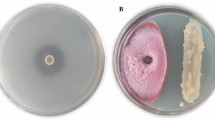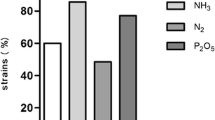Abstract
Wilt and root rot are the major constraints in chickpea production and very difficult to manage through agrochemicals. Hence, for an ecofriendly and biological management, 240 strains of Bacillus and Bacillus derived genera were isolated from chickpea rhizosphere, further narrowed down to 14 strains on the basis of in vitro production of indole acetic acid, siderophore, phosphate solubilization, hydrolytic enzymes and were evaluated for antagonism against chickpea pathogens (Fusarium oxysporum f. sp. ciceri race 1, F. solani and Macrophomina phaseolina). The strains were identified on the basis of physiological characters and 16S RNA gene sequencing. The genotypic comparisons of strains were determined by BOX-polymerase chain reaction profiles and amplified rDNA restriction analysis. These isolates were evaluated in greenhouse assay in which B. subtilis (B-CM191, B-CV235, B-CL-122) proved to be effective in reducing wilt incidence and significant enhancement in growth (root and shoot length) and dry matter of chickpea plants. PCR amplification of bacillomycin (bmyB) and β-glucanase genes suggests that amplified genes from the Bacillus could have a role to further define the diversity, ecology, and biocontrol activities in the suppression of soil-borne pathogens.





Similar content being viewed by others
References
Achouak W, Sutra L, Heulin T, Meyer JM, Fromin N, Degraeve S, Christen R, Gardan L (2000) Pseudomonas brassicacearum sp. nov. and Pseudomonas thivervalensis sp. nov., two root associated bacteria isolated from Brassica napus and Arabidopsis thaliana. Int J Syst Evol Microbiol 50:9–18
Al-Jedabi AA (2009) Biological control of Fusarium root-rot of sorghum. Res J Agric Biol Sci 5:465–473
Berg G, Krechel A, Ditz M, Sikora RA, Ulrich A, Hallmann J (2005) Endophytic and ectophytic potato-associated bacterial communities differ in structure and antagonistic function against plant pathogenic fungi. FEMS Microbiol Ecol 51:215–229
Brick JM, Bostock RM, Silverstone SE (1991) Rapid in situ assay for indole acetic acid production by bacteria immobilized on nitrocellulose membrane. Appl Environ Microbiol 57:535–538
Calvo P, Ormeño-Orrillo E, Martínez-Romero E, Zúñiga D (2010) Characterization of Bacillus isolates of potato rhizosphere from andean soils of Peru and their potential PGPR characteristics. Brazil J Microbiol 41:899–906
Cenci G, Trotta F, Caldini G (2006) Tolerance to challenges miming gastrointestinal transit by spores and vegetative cells of Bacillus clausii. J Appl Microbiol 101:1208–1215
Chernin L, Chet I (2002) Microbial enzymes in biocontrol of plant pathogens and pests. In: Burns RG, Dick RP (eds) Enzymes in the environment: activity, ecology, and applications. Marcel Dekker, New York, pp 171–225
Dey R, Pal KK, Bhatt DM (2004) Chauhan SM. Growth promotion and yield enhancement of peanut (Arachishypogaea L) by application of plant growth promoting rhizobacteria. Microbiol Res 159:371–394
El-Hassan SA, Gowen SR (2006) Formulation and delivery of the bacterial antagonist Bacillus subtilis for management of lentil vascular wilt caused by Fusarium oxysporum f. sp. lentis. J Phytopathol 154:148–155
Franks A, Ryan PR, Abbas A, Mark GL, O’Gara F (2006) Molecular tools for Studying plant growth-promoting rhizobacteria (PGPR): Molecular techniques for soil and rhizosphere microorganisms. CABI Publishing, Wallingford
Gajbhiye A, Alok RR, Sudhir UM, Dongre AB (2010) Isolation, evaluation and characterization of Bacillus subtilis from cotton rhizospheric soil with biocontrol activity against Fusarium oxysporum. World J Microbiol Biotechnol 26:1187–1194
Glickmann E, Dessaux Y (1995) A critical examination of the specificity of the Salkowski reagent for indolic compounds produced by phytopathogenic bacteria. Appl Environ Microbiol 61:793–796
Hermosa MR, Grondona I, Iturriaga EA, Diaz-Minguez JM, Castro C, Monte E, I Garcia-Acha (2000) Molecular characterization and identification of biocontrol isolates of Trichoderma spp. Appl Environ Microbiol 66:1890–1898
Huang DF, Zhang J, Song FP, Lang ZH (2007) Microbial control and biotechnology research on Bacillus thuringiensis in China. J Invertebr Pathol 95:175–180
Joshi R, McSpadden Gardener BB (2006) Identification and characterization of novel genetic markers associated with biological control activities in Bacillus subtilis. Phytopathology 96:145–154
Kiely PD, Haynes JM, Higgins CH, Franks A, Mark GL, Morrissey JP, O’Gara F (2006) Exploiting new systems-based strategies to elucidate plant bacterial interactions in the rhizosphere. Microb Ecol 51:257–266
Liu YF, Chen ZY, Ng TB, Zhang J, Zhou MG, Song FP, Liu YZ (2006) Bacisubin, an antifungal protein with ribonuclease and hemagglutinating activities from Bacillus subtilis strain B-916. Peptides 28:553–559
Lorck H (1948) Production of hydrocyanic acid by bacteria. Physiol Plant 1:142–146
Nikam PS, Jagtap GP, Sontakke PL (2007) Management of chickpea wilt caused by Fusarium oxysporium f. sp. ciceri. Afr J Agric Res 2:692–697
Pandey S, Rao JN, Sharma M (2007) Establishment of the chickpea wilt pathogen Fusarium oxysporum f. sp. ciceri in the soil through seed transmission. J Plant Pathol 23:3–6
Pospiech A, Neumann BA (1995) Versatile quick-prep of genomic DNA from gram positive bacteria. Trends Genet 11:217–218
Postma J, Schilder MT, Bloem J, Van Leeuwen-Haagsma WK (2008) Soil suppressiveness and functional diversity of the soil microflora in organic farming systems. Soil Biol Biochem 40:2394–2406
Quan CS, Wang JH, Xu HT, Fan SD (2006) Identification and characterization of a Bacillus amyloliquefaciens with high antifungal activity. Wei Sheng Wu Xue Bao 46:7–12
Rademaker JLW, de Bruijn FJ (1997) Characterization and classification of microbes by rep-PCR genomic fingerprinting and computer-assisted pattern analysis. In: Caetano-Anolles G, Gresshoff PM (eds) DNA markers: protocols, applications, and overviews. Wiley, New York, pp 151–171
Ryu CM, Farag MA, Hu CH, Reddy MS, Kloepper JW, Pare PW (2004) Bacterial volatiles induce systemic resistance in Arabidopsis. Plant Physiol 134:1017–1026
Saitou N, Nei M (1987) The neighbor-joining method: a new method for reconstructing phylogenetic trees. Mol Biol Evol 4:406–425
Schwyn B, Neilands JB (1987) Universal chemical assay for the detection and determination of siderophores. Anal Biochem 160:47–56
Sharma KD, Chen W, Muehlbauer FJ (2005) Genetics of chickpea resistance to five races of Fusarium wilt and a concise set of race differentials for Fusarium oxysporum f. sp. ciceris. Plant Dis 89:385–390
Singh RK, Kumar DP, Solanki MK, Singh P, Srivastva AK, Kumar S et al (2012) Optimization of media components for chitinase production by chickpea rhizosphere associated Lysinibacillus fusiformis B-CM18. J Basic Microbiol 52:1–10
Solanki MK, Singh N, Singh RK, Singh P, Srivastava AK, Kumar S, Kashyap PL, Arora DK (2011) Plant defense activation and management of tomato root rot by a chitin-fortified Trichoderma/Hypocrea formulation. Phytoparasitica 39:471–481
Solanki MK, Kumar S, Pandey AK, Srivastava S et al (2012a) Diversity and antagonistic potential of Bacillus spp. associated to the rhizosphere of tomato for the management of Rhizoctonia solani. Biocontrol Sci Technol 22:203–217
Solanki MK, Robert AS, Singh RK, Kumar S, Pandey AK et al (2012b) Characterization of mycolytic enzymes of Bacillus strains and their bio-protection role against Rhizoctonia solani in tomato. Curr Microbiol 65:330–336
Tariq M, Yasmin S, Hafeez FY (2010) Biological control of potato black scurf by rhizosphere associated bacteria. Brazilian J Microbiol 41:439–451
Vassilev N, Vassileva M, Nikolaeva I (2006) Simultaneous P solubilizing and biocontrol activity of microorganisms: potentials and future trends. Appl Microbiol Biotechnol 71:137–144
Acknowledgments
This work has been carried out under the network project ‘Application of Microorganisms in Agricultural and Allied Sectors’ and financially supported by Indian Council of Agricultural Research (ICAR), New Delhi, India.
Author information
Authors and Affiliations
Corresponding author
Electronic supplementary material
Below is the link to the electronic supplementary material.
Rights and permissions
About this article
Cite this article
Singh, R.K., Kumar, D.P., Singh, P. et al. Multifarious plant growth promoting characteristics of chickpea rhizosphere associated Bacilli help to suppress soil-borne pathogens. Plant Growth Regul 73, 91–101 (2014). https://doi.org/10.1007/s10725-013-9870-z
Received:
Accepted:
Published:
Issue Date:
DOI: https://doi.org/10.1007/s10725-013-9870-z




